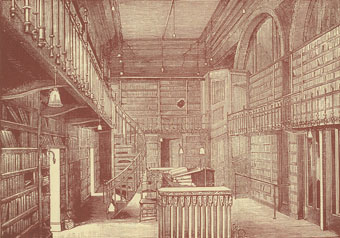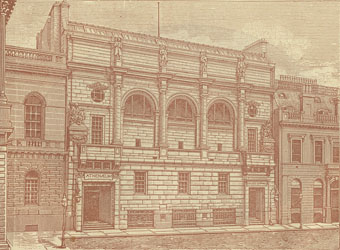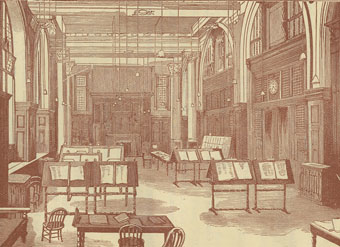This was originally published in March 2010 as part of our Item of the Month series.
Can you tell what links the authors Charles Dickens and William Thackeray, the suffragist Millicent Garrett Fawcett and Dr. Who star David Tennant?
The Glasgow Athenæum (1847-1888), a predecessor of Strathclyde University and the Royal Scottish Academy of Music and Drama.
This month’s item is the 1903-1904 Calendar for the Glasgow Athenæum which sheds light on Scottish higher education at the turn of the twentieth century, as well as providing an interesting social commentary. The calendar gives details on classes, examinations and prize lists, but somewhat unusually contains lovely illustrations featuring the building and Institution’s medals.
The Glasgow Athenæum was established in 1847 and was originally housed on Ingram Street with the purpose of providing commercial, literary and scientific training for young men and women. The inaugural address was given by Charles Dickens who described it as an
educational example and encouragement to the rest of Scotland.

The calendar states that, “the Institution combines the advantages and comforts of a club, with extensive Educational Departments.” Facilities included a library, recreation rooms, restaurant, concert and lecture halls. Interestingly, the calendar gives a list of newspapers and magazines which shows the social and political situation at the time. These include diverse publications such as Anti-Slavery Reporter, Arms & Explosives and Gentlewoman. There was also a separate Ladies’ Department which included reading, writing, conversation, dining, luncheon and tea rooms with a lady attendant. Indeed, it has been suggested that the Athenæum was the first ladies’ club in the city.
Glasgow had a strong history of educating women despite the fact that this was not mandatory until 1892 with John Anderson, the founder of Anderson’s Institution (1796-1828), a proponent of this. Dickens also appeared to favour this inclusion when he suggested that:
If the young men of Glasgow want any stimulus or encouragement in this wise, they have one beside them in the presence of their fair townswomen, which is irresistible. It is a most delightful circumstance to me, and one fraught with inestimable benefits to institutions of this kind, that at meetings of this nature those who in all things are our best examples, encouragers, and friends, are not excluded.

The initial membership was 1612 which rose to 2133 six months later. The calendar shows that some classes started as early as 6.30am whilst others finished at 10pm., a far cry from today’s student timetable. Classes were initially held in English grammar and literature, logic, French and German, shortly followed by mathematics, elocution and Italian. The mandate was similar to Anderson’s goal to establish a “place of useful learning.”
Pictured opposite is St George's place building (now Nelson Mandela Place). It was designed and erected by John Burnet, Son & Campbell. The Athenæum moved there in 1888.
The Athenæum attracted considerable interest. Guest speakers included Anthony Trollope (1869), Emily Faithfull (1870), Millicent Garrett Fawcett (1870), Lydia Becker (1870), Lord Kelvin (1866) and Ralph Waldo Emerson (1848). The Evening Times also published a weekly gossip section on the Athenæum, scrapbooks of which can be found in the collection.
In 1888 the commercial side of the institution became known as Glasgow Athenæum Commercial College, a predecessor of the University of Strathclyde, whilst the Glasgow Athenæum (Limited) School of Music was formed in 1890 and offered courses in music, art, elocution and dramatic art. This later became known as the Royal Scottish Academy of Music and Drama and produced notable alumni such as Ruby Wax, Elaine C. Smith, Daniela Nardini, John Hannah, Alan Cumming, Robert Carlyle, Billy Boyd, James McAvoy, Dougie Vipond and David Tennant.

This calendar gives information on both sections of the Athenæum. The Commercial College section notes that morning and evening classes are “open to both sexes on equal terms, unless where otherwise stated.” Specific classes for ladies were held in subjects such as French, German, English – Grammar, Composition & Literature, Writing and Book-keeping, Ambulance, Physiology and Sick Nursing. Women could also be enrolled in ordinary classes yet despite the forward-thinking nature of the institution, societal norms prevailed. For instance,
in the event of marriage, Women Clerks have to resign their appointments, but they then receive, in lieu of the pension to which all Civil Servants are entitled, a marriage portion, the amount of which is determined by the length of their service.
A number of oddities can be seen in the calendar. For example, female learners undertaking Post Office training had to be over 5 feet in height, whilst male Assistants of Customs had to be over 5 feet 4 inches and “any candidate whose chest measurement falls short of the normal standard corresponding to his height will be liable to rejection.”
It is these quirks combined with the presentation of the calendar which make this item interesting and worthy of further attention.
Lindsey Short, Archival Assistant
Please note: The records of the Glasgow Athenaeum (ref: OH/1), which had been on long term loan to the University since the 1980s, have now been returned to their owners, the Royal Conservatoire of Scotland. Contact archives@rcs.ac.uk for more information.
